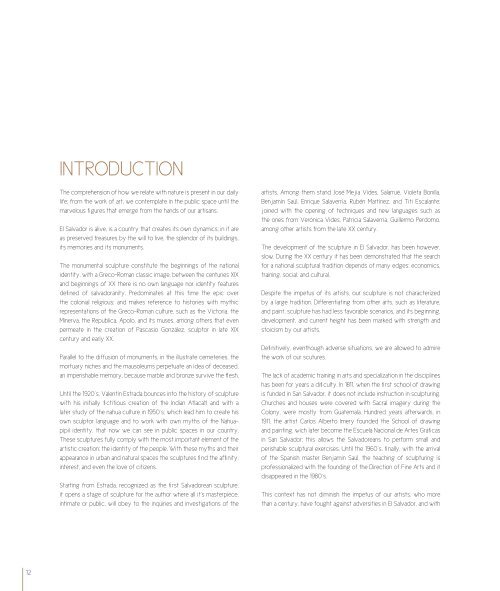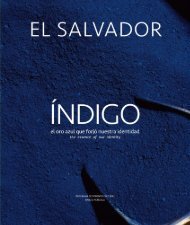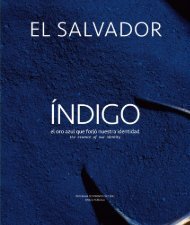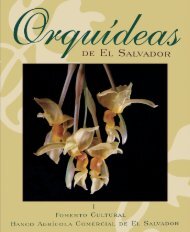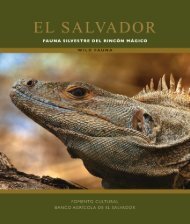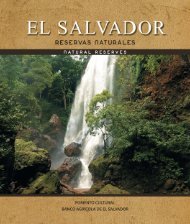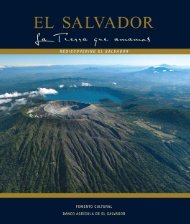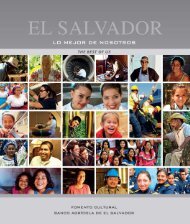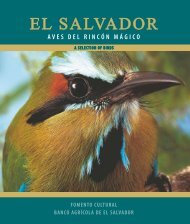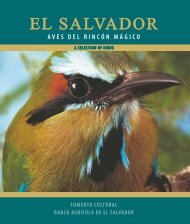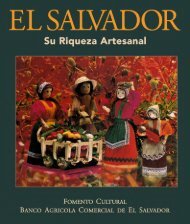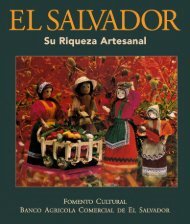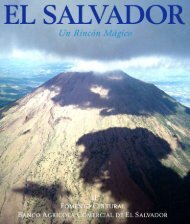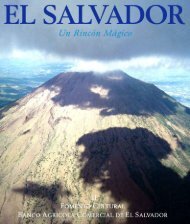Monumentos y Esculturas
You also want an ePaper? Increase the reach of your titles
YUMPU automatically turns print PDFs into web optimized ePapers that Google loves.
INTRODUCTION<br />
The comprehension of how we relate with nature is present in our daily<br />
life: from the work of art, we contemplate in the public space until the<br />
marvelous figures that emerge from the hands of our artisans.<br />
El Salvador is alive, is a country that creates its own dynamics; in it are<br />
as preserved treasures by the will to live, the splendor of its buildings,<br />
its memories and its monuments.<br />
The monumental sculpture constitute the beginnings of the national<br />
identity, with a Greco-Roman classic image, between the centuries XIX<br />
and beginnings of XX there is no own language nor identity features<br />
defined of salvadoranity. Predominates at this time the epic over<br />
the colonial religious; and makes reference to histories with mythic<br />
representations of the Greco-Roman culture, such as the Victoria, the<br />
Minerva, the Republica, Apolo, and its muses, among others that even<br />
permeate in the creation of Pascasio González, sculptor in late XIX<br />
century and early XX.<br />
Parallel to the diffusion of monuments, in the illustrate cemeteries, the<br />
mortuary niches and the mausoleums perpetuate an idea of deceased,<br />
an imperishable memory, because marble and bronze survive the flesh.<br />
Until the 1920´s, Valentín Estrada bounces into the history of sculpture<br />
with his initially fictitious creation of the Indian Atlacatl and with a<br />
later study of the nahua culture in 1950´s; which lead him to create his<br />
own sculptor language and to work with own myths of the Nahuapipil<br />
identity, that now we can see in public spaces in our country.<br />
These sculptures fully comply with the most important element of the<br />
artistic creation; the identity of the people. With these myths and their<br />
appearance in urban and natural spaces the sculptures find the affinity,<br />
interest, and even the love of citizens.<br />
Starting from Estrada, recognized as the first Salvadorean sculpture,<br />
it opens a stage of sculpture for the author where all it’s masterpiece,<br />
intimate or public, will obey to the inquiries and investigations of the<br />
artists. Among them stand José Mejía Vides, Salarrué, Violeta Bonilla,<br />
Benjamín Saúl, Enrique Salaverría, Rubén Martínez, and Titi Escalante;<br />
joined with the opening of techniques and new languages such as<br />
the ones from Verónica Vides, Patricia Salaverría, Guillermo Perdomo,<br />
among other artists from the late XX century.<br />
The development of the sculpture in El Salvador, has been however,<br />
slow. During the XX century it has been demonstrated that the search<br />
for a national sculptural tradition depends of many edges: economics,<br />
training, social, and cultural.<br />
Despite the impetus of its artists, our sculpture is not characterized<br />
by a large tradition. Differentiating from other arts, such as literature,<br />
and paint, sculpture has had less favorable scenarios, and its beginning,<br />
development, and current height has been marked with strength and<br />
stoicism by our artists.<br />
Definitively, eventhough adverse situations, we are allowed to admire<br />
the work of our scutures.<br />
The lack of academic training in arts and specialization in the disciplines<br />
has been for years a dificulty. In 1811, when the first school of drawing<br />
is funded in San Salvador, it does not include instruction in sculpturing.<br />
Churches and houses were covered with Sacral imagery during the<br />
Colony, were mostly from Guatemala. Hundred years afterwards, in<br />
1911, the artist Carlos Alberto Imery founded the School of drawing<br />
and painting, wich later become the Escuela Nacional de Artes Gráficas<br />
in San Salvador; this allows the Salvadoreans to perform small and<br />
perishable sculptural exercises. Until the 1960´s, finally, with the arrival<br />
of the Spanish master Benjamín Saúl, the teaching of sculpturing is<br />
professionalized with the founding of the Direction of Fine Arts and it<br />
disappeared in the 1980´s.<br />
This context has not diminish the impetus of our artists, who more<br />
than a century, have fought against adversities in El Salvador, and with<br />
resilience and vocational strength have succeeded and developed<br />
riches and foundational works of art.<br />
The sculpture is one of the vehicles to know and understand our<br />
identity. Through it and during centuries, the citizens have known<br />
their history and that of their towns. The work of art will remain<br />
over us, since the material over which the sculpture is made, is in<br />
general imperishable.<br />
The trace in the history of sculpture of El Salvador will be finally,<br />
a sculpture. Men will die, but not their statues. And the statues are<br />
their memory.<br />
Elena Salamanca<br />
Writer – Historian<br />
La Volcaneña,<br />
Titi Escalante.<br />
12 13


